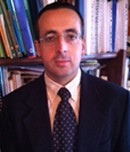
Plenary Lecture
Rhythm Analysis of the ”Sonorous Continuum”: Representations and Algorithms for Symbolic Musical Data

Professor Michele Della Ventura
Department of Technology
Music Academy “Studio Musica”
Treviso, Italy
E-mail: michele.dellaventura@tin.it
Abstract: Music is the meeting place par excellence for arts and sciences and within this meeting, mathematics plays an essential and central role. The relations between Music and Mathematics are very close both at elementary and more complex levels. These relations are easily comprehensible even for the uninitiated, for instance with respect to note durations (double or half, quarter and so on): rhythm is a number, it is the precise measure of time. Rhythm is an element that confers a musical piece a special physiognomy and while listening to it, it allows the listener to perform a segmentation of the sonorous continuum, seizing in it contrasts and consonances: sound clusters are collocated in rhythmic and melodic schemata, in which themes, motifs, repetitions, variations emerge. The musical content, therefore, does not exhaust itself into the mere acoustic and perceptual fact, but has a meaning that emerges from the structural properties of the piece, cognitively elaborated by the listener and traced back to conceptual structures.
This study presents a model of rhythm analysis able to explore progressively the symbolic level of the musical text, identifying the rhythmic cells on the basis of the information that every single one of them carries. The efficiency of the model was checked analyzing various musical pieces by different authors and of different times, trying to range over different styles by means of a single analysis methodology.
Brief Biography of the Speaker: Michele Della Ventura defined his professional training, since high school, within the framework of two distinct areas of study: music and mathematics.
He brilliantly graduated in piano and he graduated in technology disciplines with the highest honors and distinction, obtaining a scholarship, defending the thesis entitled “Study on the implementation of algorithms for the melodic operators in the symbolic text segmentation and conjoint evaluation of musical entropy”.
His dual formation, in Information Technology and music, drives him into carrying out research activities on the relation between Music and Mathematics. The development of education-related technologies draw him to focus his attention on the innovations of information technology associated to musical programming languages and to attend a Post-Graduate Master's Degree on E-Learning (E-Learning: methods, techniques and applications) at the University Tor Vergata of Rome, graduating from it with the highest marks with the thesis "Learning and new technologies".
His research activity continues within the framework of computer-aided musical analysis, publishing articles and holding national and international conferences and seminars on “Music and new technologies”.
He combines his research and IT consultant activity with the position of Music informatics Professor at Music Academies and Conservatories and the position of Musical Technologies Teacher in High Schools specializing in Music.